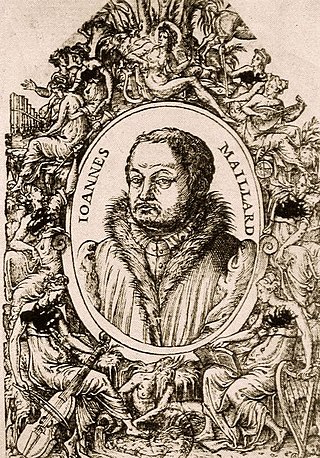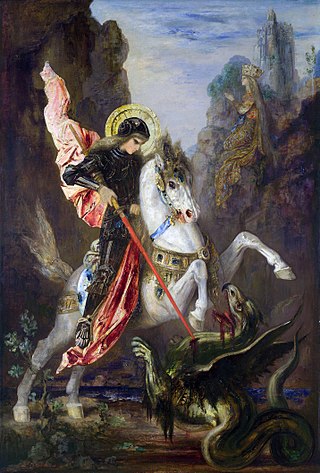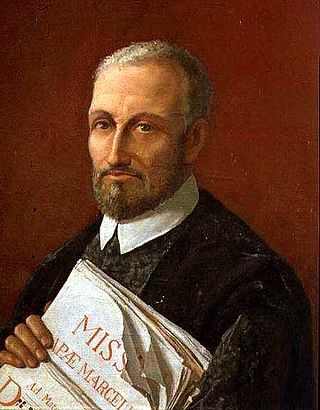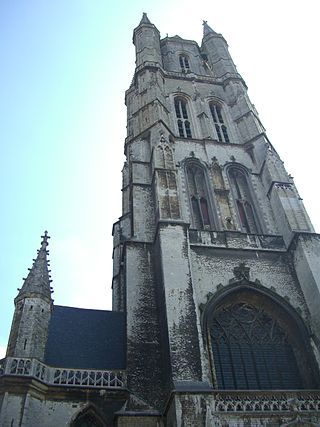
Josquin Lebloitte dit des Prez was a composer of High Renaissance music, who is variously described as French or Franco-Flemish. Considered one of the greatest composers of the Renaissance, he was a central figure of the Franco-Flemish School and had a profound influence on the music of 16th-century Europe. Building on the work of his predecessors Guillaume Du Fay and Johannes Ockeghem, he developed a complex style of expressive—and often imitative—movement between independent voices (polyphony) which informs much of his work. He further emphasized the relationship between text and music, and departed from the early Renaissance tendency towards lengthy melismatic lines on a single syllable, preferring to use shorter, repeated motifs between voices. Josquin was a singer, and his compositions are mainly vocal. They include masses, motets and secular chansons.

The Mass is a form of sacred musical composition that sets the invariable portions of the Christian Eucharistic liturgy, known as the Mass.

Johannes Ockeghem was a Franco-Flemish composer and singer of early Renaissance music. Ockeghem was a significant European composer in the period between Guillaume Du Fay and Josquin des Prez, and he was—with his colleague Antoine Busnois—a prominent European composer in the second half of the 15th century. He was an important proponent of the early Franco-Flemish School.

Adrian Willaert was a Flemish composer of High Renaissance music. Mainly active in Italy, he was the founder of the Venetian School. He was one of the most representative members of the generation of northern composers who moved to Italy and transplanted the polyphonic Franco-Flemish style there.
Antoine Brumel was a French composer. He was one of the first renowned French members of the Franco-Flemish school of the Renaissance, and, after Josquin des Prez, was one of the most influential composers of his generation.
Nicolas Gombert was a Franco-Flemish composer of the Renaissance. He was one of the most famous and influential composers between Josquin des Prez and Palestrina, and best represents the fully developed, complex polyphonic style of this period in music history.

Jacob Obrecht was a Flemish composer of masses, motets and songs. He was the most famous composer of masses in Europe of the late 15th century and was only eclipsed after his death by Josquin des Prez.
In music, a cantus firmus is a pre-existing melody forming the basis of a polyphonic composition.
Jean Richafort was a Netherlandish composer of the Renaissance, a member of the third generation of the Franco-Flemish School.
Johannes Martini was a Franco-Flemish composer of the Renaissance.

Jean Maillard was a French composer of the Renaissance.
In Renaissance music, the cyclic mass was a musical setting of the Ordinary of the Roman Catholic Mass, in which each of the movements – Kyrie, Gloria, Credo, Sanctus, and Agnus Dei – shared a common musical theme, commonly a cantus firmus, thus making it a unified whole. The cyclic mass was the first multi-movement form in western music to be subject to a single organizing principle.
Soggetto cavato is an innovative technique of Renaissance composer Josquin des Prez that was later named by the theorist Zarlino in 1558 in his Le istitutioni harmoniche as soggetto cavato dalle vocali di queste parole, or literally, a subject 'carved out of the vowels from these words.' It is an early example of a musical cryptogram.

A paraphrase mass is a musical setting of the Ordinary of the Mass that uses as its basis an elaborated version of a cantus firmus, typically chosen from plainsong or some other sacred source. It was a common means of mass composition from the late 15th century until the end of the 16th century, during the Renaissance period in music history, and was most frequently used by composers in the parts of western Europe which remained under the direct control of the Roman Catholic Church. It is distinguished from the other types of mass composition, including cyclic mass, parody, canon, soggetto cavato, free composition, and mixtures of these techniques.

The Missa Caput was a musical setting of the Roman Catholic mass, dating from the 1440s, by an anonymous English composer. It circulated widely on the European continent in the mid-15th century and was one of the best-loved musical works of the early Renaissance in Europe, judging by the number of copies that have survived, and the number of imitations it inspired. It was influential both for its use of a tenor cantus firmus which unified all the movements and for being the first extended composition with a freely composed bass line, a feature with extraordinary ramifications in music history. Among the many composers influenced by it are Guillaume Du Fay and Johannes Ockeghem.

Missa Papae Marcelli, or Pope Marcellus Mass, is a mass sine nomine by Giovanni Pierluigi da Palestrina. It is his best-known mass, and is regarded as an archetypal example of the complex polyphony championed by Palestrina. It was sung at the papal coronation Masses.
The Missa Pange lingua is a musical setting of the Ordinary of the Mass by Franco-Flemish composer Josquin des Prez, probably dating from around 1515, near the end of his life. Most likely his last mass, it is an extended fantasia on the Pange Lingua hymn, and is one of Josquin's most famous mass settings.

The Missa L'homme armé super voces musicales is the first of two settings of the Ordinary of the Mass by Josquin des Prez using the famous L'homme armé tune as his cantus firmus source material. The setting is for four voices. It was the most famous mass Josquin composed, surviving in numerous manuscripts and print editions. The earliest printed collection of music devoted to a single composer, the Misse Josquin published by Ottaviano Petrucci in 1502, begins with this famous work.

The Missa de Beata Virgine is a musical setting of the Ordinary of the Mass, by Renaissance composer Josquin des Prez. Though formerly believed to have been a late composition on the basis of stylistic analysis, evidence from Burchard’s Diary proves that the mass was written sometime before September 23, 1497. It was the most popular of his masses in the 16th century.

Jheronimus Vinders was a Franco-Flemish composer of the Renaissance, active at Ghent. He was a minor member of the generation after Josquin des Prez, and he also composed a notable lament on the more famous composer's death.










